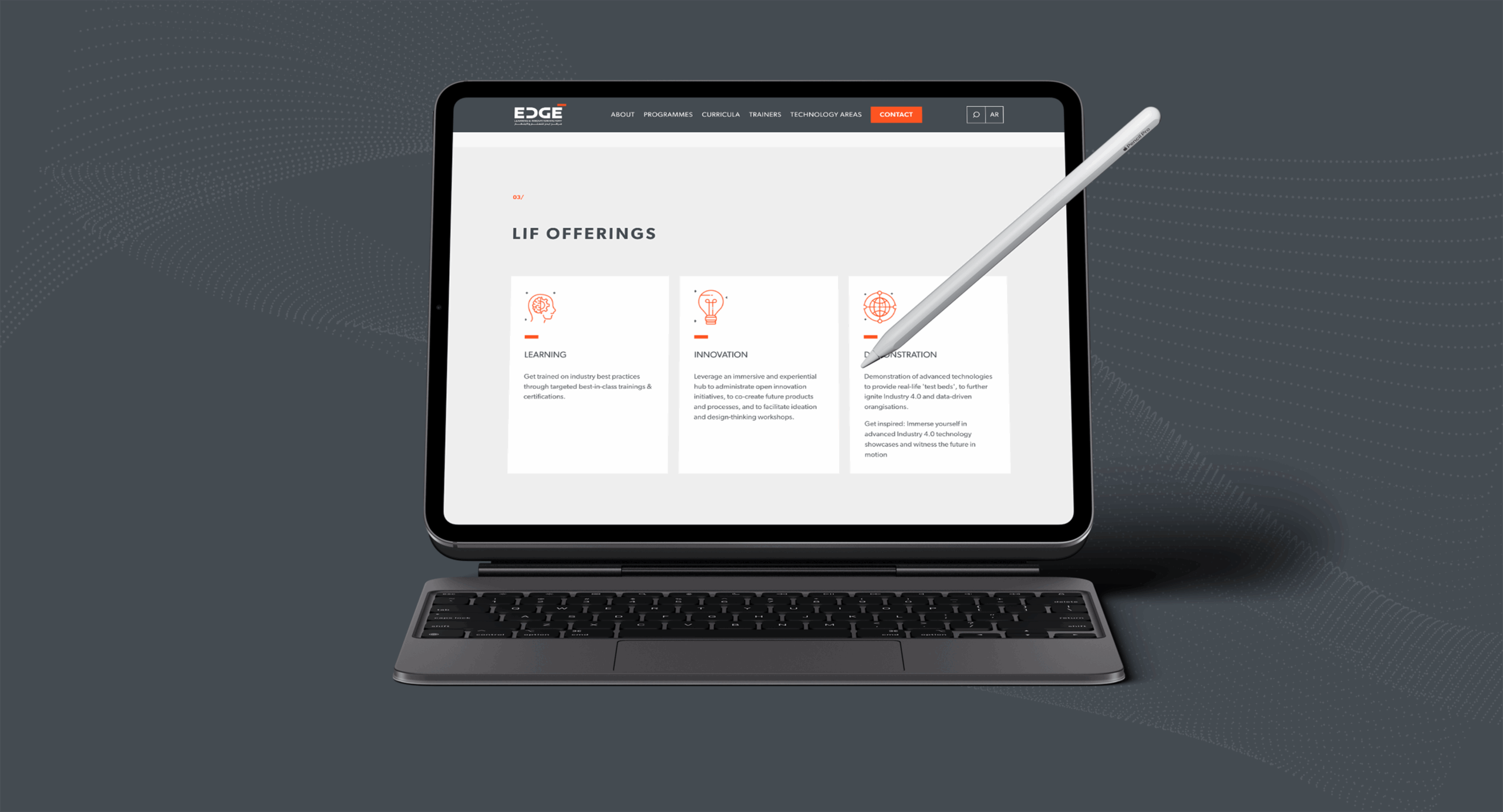Looking for a GA4 migration guide but not sure how to begin? You’re not alone. GA4 is entirely different from Universal Analytics, when it comes to data organization, data collection model, metrics and how they are calculated. This means, you should follow a a proper guide to GA4 migration checklist and plan.
UA to GA4 Migration is a challenging task if you don’t have experience with data migrations. So, how do you begin it? Make a migration plan, prepare checklist and identify steps to implement.
We’ve been busy with GA4 migration from existing UA ensuring that all the historical data is being saved, and we created a guide to GA4 migration checklist with steps that will be useful to anyone looking for a GA4 migration plan of their own.
To get you started, here’s an outline GA4 migration plan.
GA4 Migration Deadline
In July 2023, the default Universal Analytics (UA) will disappear. The GA4 Migration deadline is near and there’s not much time left until Universal Analytics stops gathering data.
So if you still rely on UA, prepare to use Google Analytics 4 (GA4) instead. Our primary concern is that our clients and businesses do not lose access to their Google Analytics historical data in UA properties until that time. Get in touch if we share the same concern.
Need assistance with GA4 Migration?
Looking for a GA4 migration service but not sure how to begin? You’re not alone. GA4 is entirely different from Universal Analytics, when it comes to data organization, data collection model, metrics and how they are calculated. This means, you should follow a a proper guide to GA4 migration checklist and plan.
Get in touch with us for assistance with migrating Google Analytics UA to Google Analytics GA4. The sooner you do the Google Analytics 4 migration, the more Google Analytics historical data you can keep and the more efficiently you can track your customers’ journey. For more information, contact us.
Error: Contact form not found.
What’s GA4?
Google Analytics 4 (GA4) is the new version of Google Analytics (GA) that tracks app and web visits in a single GA property rather than separating these platform visits into different GA parts.
No doubt, initially, it was annoying news. Nevertheless, after recognizing the features of GA4, you’ll never regret migrating from universal analytics to GA4. Most of you must consider the significant differences between universal analytics and google analytics 4.
The below table will guide you with the important differences between universal analytics and Google Analytics 4.
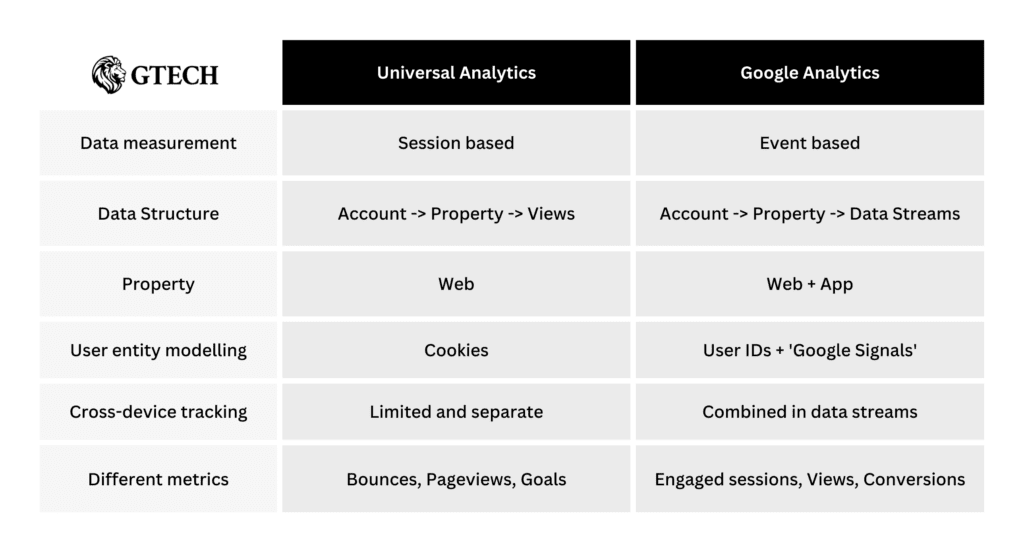
Why Is Google Analytics Historical Data Not Imported Automatically?
You cannot import your Google Analytics historical data from UA to GA4 because the two versions have different data collection models. And it’s unlikely that Google will provide a quick fix for this UA to GA4 migration problem. So you need to plan and act before the GA4 migration deadline approaches.
You can’t move your data to GA4 because the two versions (GA4 and UA) use completely different data models (schema and dimension). Also, the definitions and calculations are done differently in the two property types.
Without using too many technical terms, we’ll guide you on how the data is changed and how the algorithms ensure compatibility.
Save your GA Historical Data before planning UA to GA4 migration
So we’ve learned that we can’t import Google Analytics historical data/reports to GA4, but the good news is that you can save them. And here are three ways that guide you to save your UA data before you do the UA to GA4 migration plan:
Export Your Data Manually
Exporting data is the easiest way to get it from your Google Analytics account.
Open the GA standard report you need – Acquisition > All Traffic > Source/Medium. Customize it accordingly and click EXPORT in the upper right corner and select your preferred file extension (.pdf, .xlsv, .csv)
Remember, however, that there are some limitations – for example, you only have two arrays, limited to a maximum of 5,000 rows.
Google Analytics Sheets Add-On
In this case, the Google Analytics add-on is responsible for exporting data from Google Analytics. You can install the GA add-on from the Google Workspace Marketplace.
Here is a guide to the GA4 migration steps to follow
Step 1: Install Add-on
- Create a folder in Google Drive for your Google Analytics historical data.
- In the folder, create a Google Sheet.
- Click Extensions along the top menu navigation in your Google Sheets.
- Select Add Ons.
- Click Get Add-Ons next.
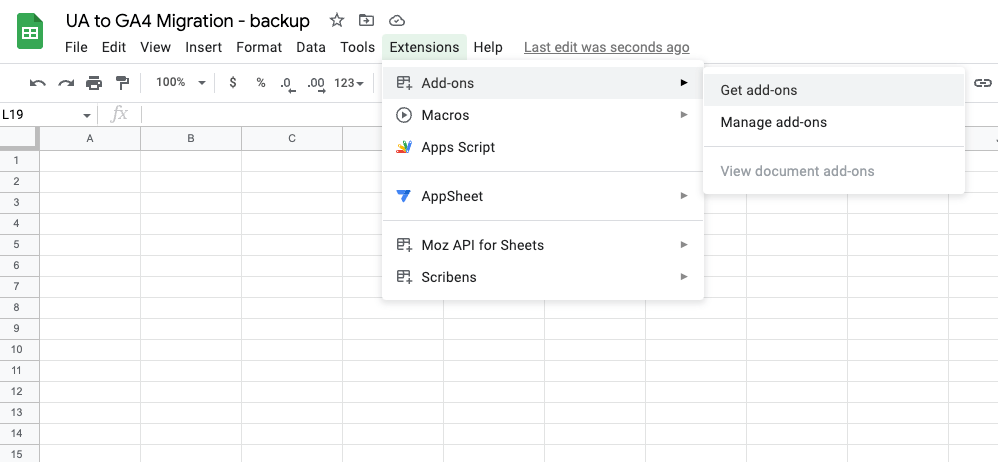
- You’ll be redirected to the Google Workspace Marketplace where you should search for the Google Analytics App.
- Install the Google Analytics app by following the prompts as needed for authorization.
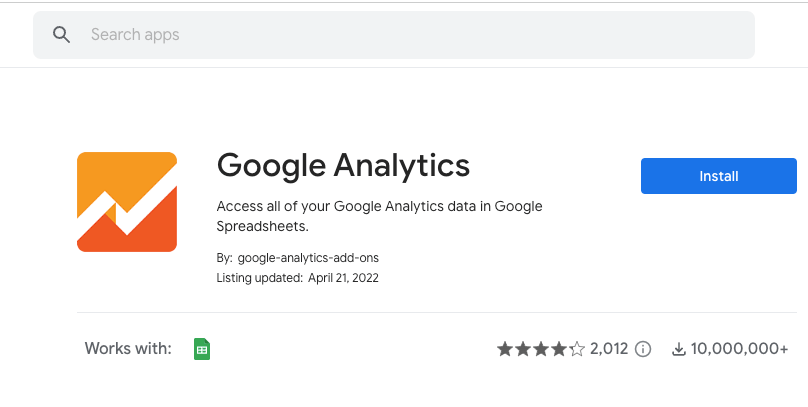
Step 2: Define configuration options
- Now, go back to your Google Sheet.
- Click Extensions.
- This time, the Google Analytics app should be visible.
- Select the Google Analytics app and click on Create new report.
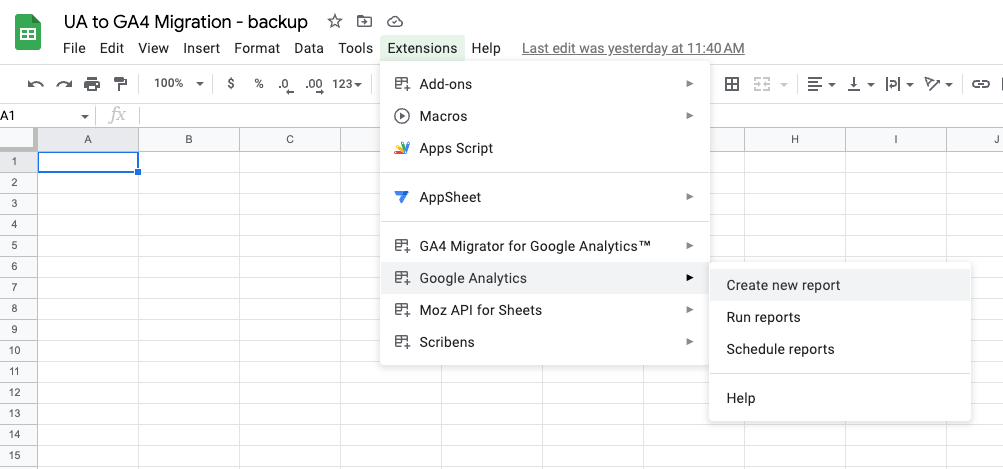
- To start exporting your Google Analytics historical data, name your report. Eg: ‘2022 User Acquisition’
- Select your preferred or required view: Account, Property, and View.
- Then, choose your configuration options based on certain metrics, dimensions, and segments.
Eg: Here we chose ‘Users’, ‘Sessions’ and ‘Bounce Rate’ as Metrics, and “source” and “medium” as Dimensions. The field for Segments is left empty to extract all users data.
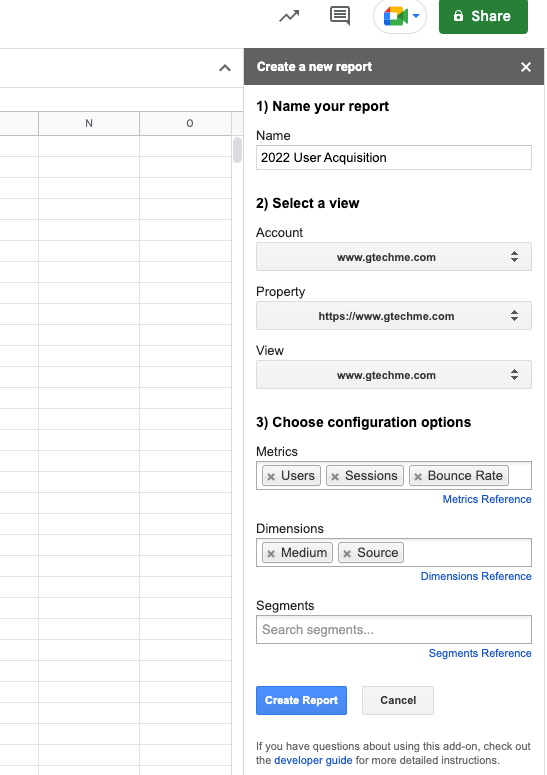
- Click on Create Report and you can see the report configurations generated.
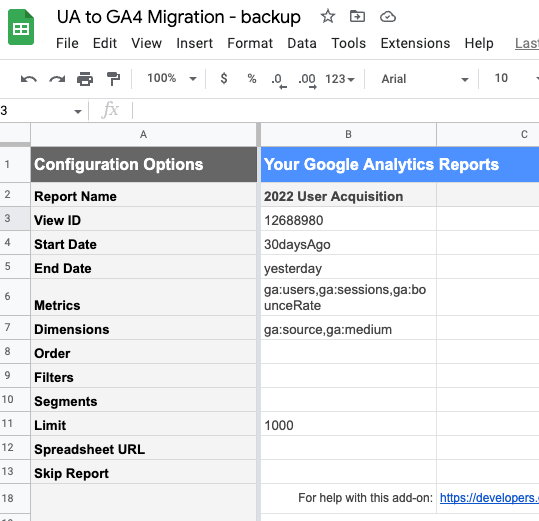
- You will be redirected to additional configuration options that you can use as needed.
For instance, change the date range following the format YYYY-MM-DD.
Apart from that, you can add filters like country, ga:country==United Arab Emirates.
Change the Limit based on the requirement. The Limit by default is ‘1000′
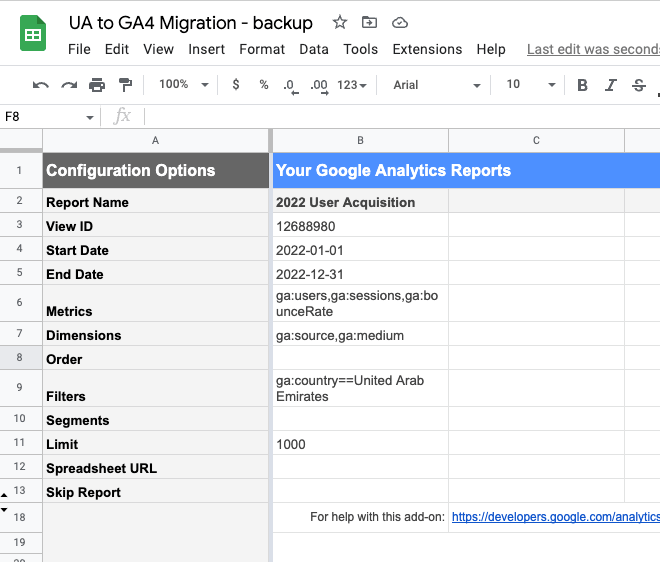
Step 3: Run reports
- Then, click on Extensions.
- Select Google Analytics.
- You can then export your GA historical data by clicking on Run reports.
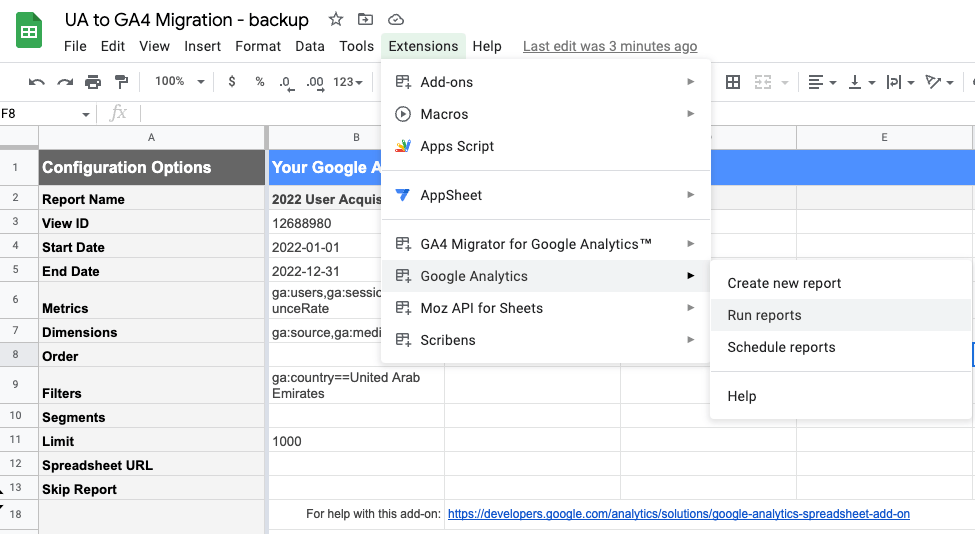
- A report status will pop up and let you know when your report is successful. Click ‘Ok’
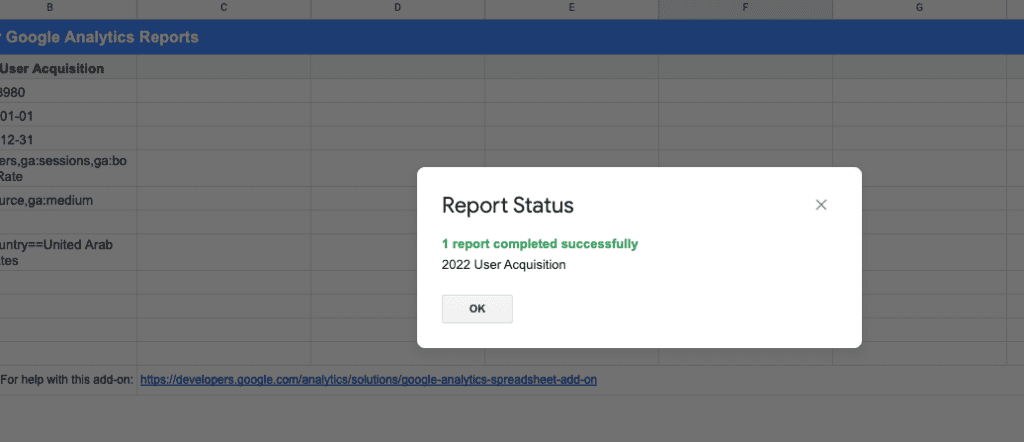
If there are mistakes, then you need to go back to and address them.
- You could view the report generated in the next tab
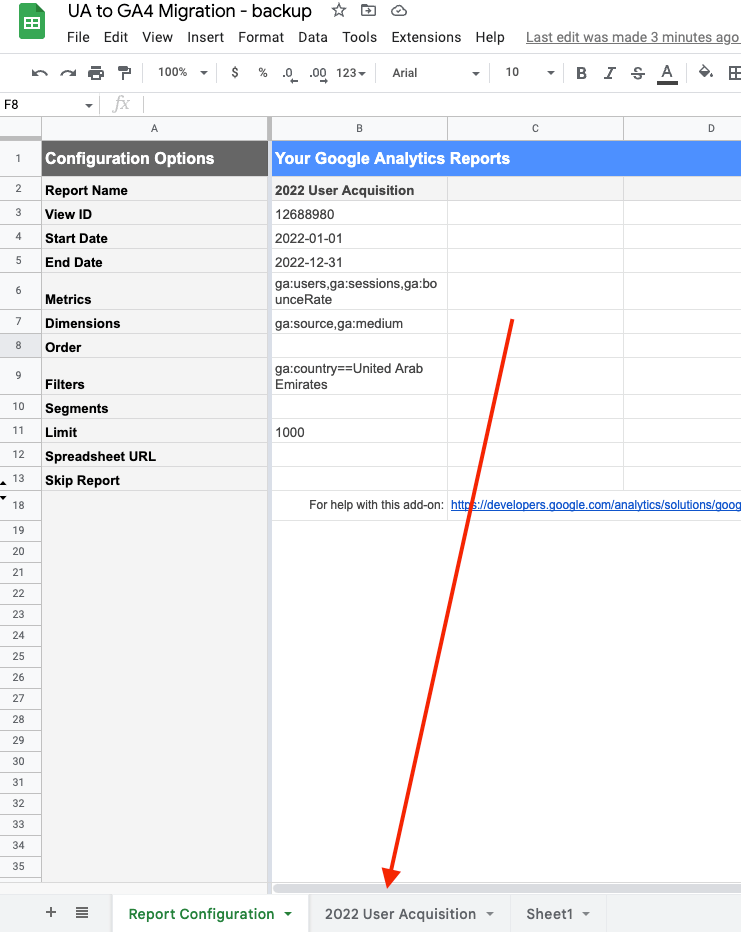
Alternatively, the videos below guide you through how to download and install the Google Analytics Spreadsheet add-on. It also guides you through building a dashboard that’ll automatically update which you can choose to embed on a third-party website.
GA4 Migration Guide Using the Google Analytics Spreadsheet Add-on
Building a dashboard with the Google Analytics Spreadsheet Add-on
The advantages of this method include
- Data is transferred from Google Analytics directly into Google Sheets.
- Freedom to customise dimensions and metrics in your exported report.
- You can specify the maximum number of rows to be returned for your GA report.
You can plan and automate exporting historical data from Google Analytics to Google Sheets on a schedule – for example, every day between 4 pm and 5 pm.
Google Analytics API for Fetching Datasets
The Google Analytics Reporting API v4 provides programmatic access to your GA historical data in Universal Analytics (but not GA4). The application programming interface (API) has several advantages over regular Google Analytics UI. For example, the Core Reporting API provides access to most reporting data in Google Analytics, making it an ideal option for your UA to GA4 migration.
A lack of coding skills can be a significant problem for many users to enjoy this advanced analytics option. However, even tech-savvy users who use API connectors such as JSON Client by Coupler.io can benefit from Google Analytics APIs.
Google Analytics API provides a viable method for archiving large amounts of data from Google Analytics, including real-time and historical data.
A Guide to UA to GA4 Migration: Checklist and Steps
There’s no better time than now to start planning, converting, or migrating any Universal Analytics (UA) property you have to Google Analytics 4 (GA4). As of July 1, this year, all standard UA properties are scheduled to stop processing new hits and the same goes for 360 UA as of July 1, next year.
Everyone needs to plan a GA4 migration guide and checklist as soon as possible apart from saving Google analytics historical data for more insights as they switch to GA4.
Here is the Guide to UA to GA4 migration checklist with steps you need to take.
Step 1: Audit your UA property
The first step in the UA to GA4 migration checklist is performing an audit to get a deeper understanding of your UA account. We recommend planning a document where you can take note of all observations as your audit is being conducted which you can refer to during the migration.
Here’s a sample of a UA to GA4 migration template that will guide you through the process.
Step 2: Export the Historical Data from Google Universal Analytics
Next in the GA4 migration checklist, you will need to export your historical data to move forward with your GA4 migration plan. You can export your data manually, use the Google Analytics Sheets add-on, or the Google Analytics API v4 as elaborated above.
Step 3: Plan the structure of your GA4 account
To import UA to GA4, you need to plan out your account’s structure beforehand:
- Think about your business requirements.
- Decide how many properties you need to set up.
- Choose as many data streams as needed.
Step 4: Set up GA4 account
Now, you can set up your GA4 account by using the GA4 Setup Assistant. Using the Editor role:
- Click Admin found on the lower left of GA4.
- Hover over Account and choose your preferred or required account.
- Hover over Property and select the UA property that currently collects data for your website.
- Click GA4 Setup Assistant in Property.
- Hover over I want to create a new Google Analytics 4 property.
- Click on Get started.
- Select Create and continue from the pop-up to Set up a Google tag page.
- Select Create property to reuse your current UA tagging for your upcoming GA property.
Afterwards, you will see “You have successfully connected your properties” at the top of the page.
Step 5: Link GA4 to other tools
You can then link GA4 to other tools like Google Ads by using the Editor role:
- Click Admin found on the lower left of GA4.
- Hover over Account and choose your preferred or required account.
- Hover over Linking and select Import existing Google Ads links from your connected Universal Analytics property.
- Click on Get started.
- Select your Google Ads links to be imported.
- Click Import selected Ads links in the top right.
- Click Ok as the confirmation message appears.
If you have successfully linked GA4 to this tool, you should see “Your Google Ads links have been imported successfully.”
Step 6: Manage Users
Looking at Google Analytics UA vs GA4, you can easily manage users with the Administrator role:
- After installing the GA4 Migrator for Google Analytics add-on from the Google Workspace Marketplace, create a new Google Sheet.
- Hover over Extensions and click on GA4 Migrator for Googe Analytics.
- Then, click on Migrate users to GA4.
- Select an account from the drop-down menu.
- Select a Universal Analytics property from the drop-down menu.
- Click on Import users from Universal Analytics.
- After you’ve received the confirmation methods, you will be able to see a report with all user permissions.
- When every row in the sheet is labelled “Ready to migrate,” you can export user permissions to your GA4 property.
- As you see in the migration dialogue’s drop-down menu, select a GA4 property.
- Click on Migrate.
Afterwards, “User migration complete” should pop up.
Step 7: Configure Filters/Conversions
Create or configure filters with the Admin role in GA4, one of the important steps in GA4 migration checklist.
- Hover over Property.
- Select Data Streams.
- Choose your preferred or required data stream.
- Scroll down and click on Additional Settings and choose from the available options as needed.
Step 8: Create Custom dimensions if any
You can choose from the following levels of scope in UA: Hit, Product, Session, and User. However, with GA4, you can create custom dimensions as needed:
- Click on New custom dimension.
- Select Event or User in the Scope drop-down menu.
- Fill out the Dimension name and Description.
- Then, select an event parameters
- Click Save.
Beware of the Limitations of the API & Add-On
Still, there are some things that could be improved regarding the use of API and add-ons to extract your data for Google Analytics 4 migration.
For example, with these methods, you don’t have access to raw data such as client_id (client identifiers), which is generously provided through the native use of BigQuery.
Also, the method discussed in the migration checklist output in a simple format (which more advanced tools can compare to nested data); you must ensure that you combine the available dimensions and metrics into a single query.
Can Google Analytics Export All Data at Once?
We apologize if you’re one of those users who’d like to see a magic “Export All” button to instantly save all the GA historical data. That magic button doesn’t exist. But you’ve three options, which we’ve described above.
Bottom Line
The sooner you do the Google Analytics 4 migration, the more Google Analytics historical data you can keep and the more efficiently you can track your customers’ journey. For more information, contact us.
If you are looking for a free GA4 migration service, Connect with GTECH.
Need more information? Check out more resources:
What Will Happen to Universal Analytics Properties After July 1st?
Switch to GA4, or Google will make it for you
Google Analytics 4 (GA4) Problems Associated with Migration and How Google Addresses Them
What to Expect as GA4 Becomes Your Primary Measurement Platform?
The Biggest Misconceptions About GA4
Google Analytics 4 Vs Universal Analytics: What’s The Difference
Google Analytics 4: Where can you find the Demographic and Tech details reports
Related Post
Publications, Insights & News from GTECH






